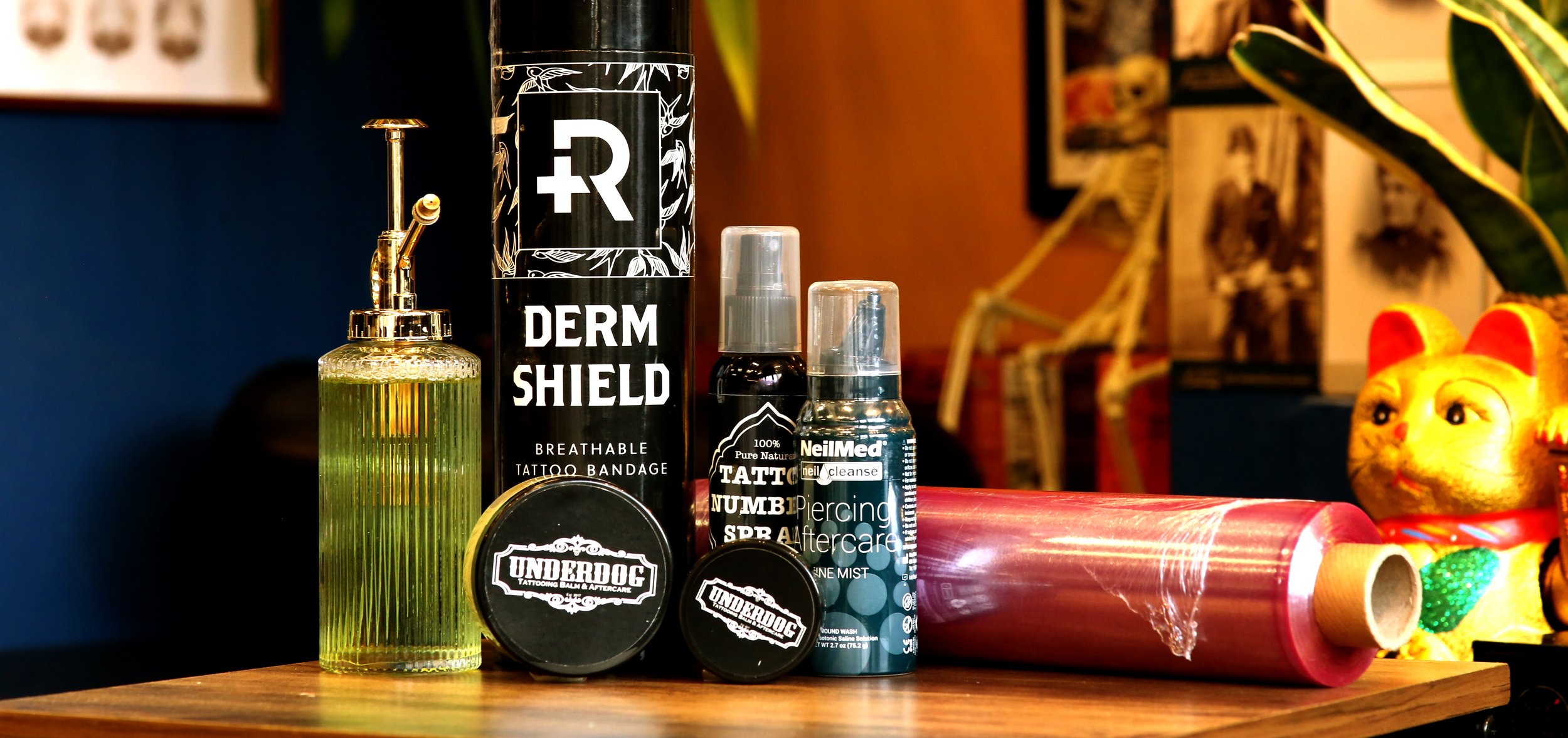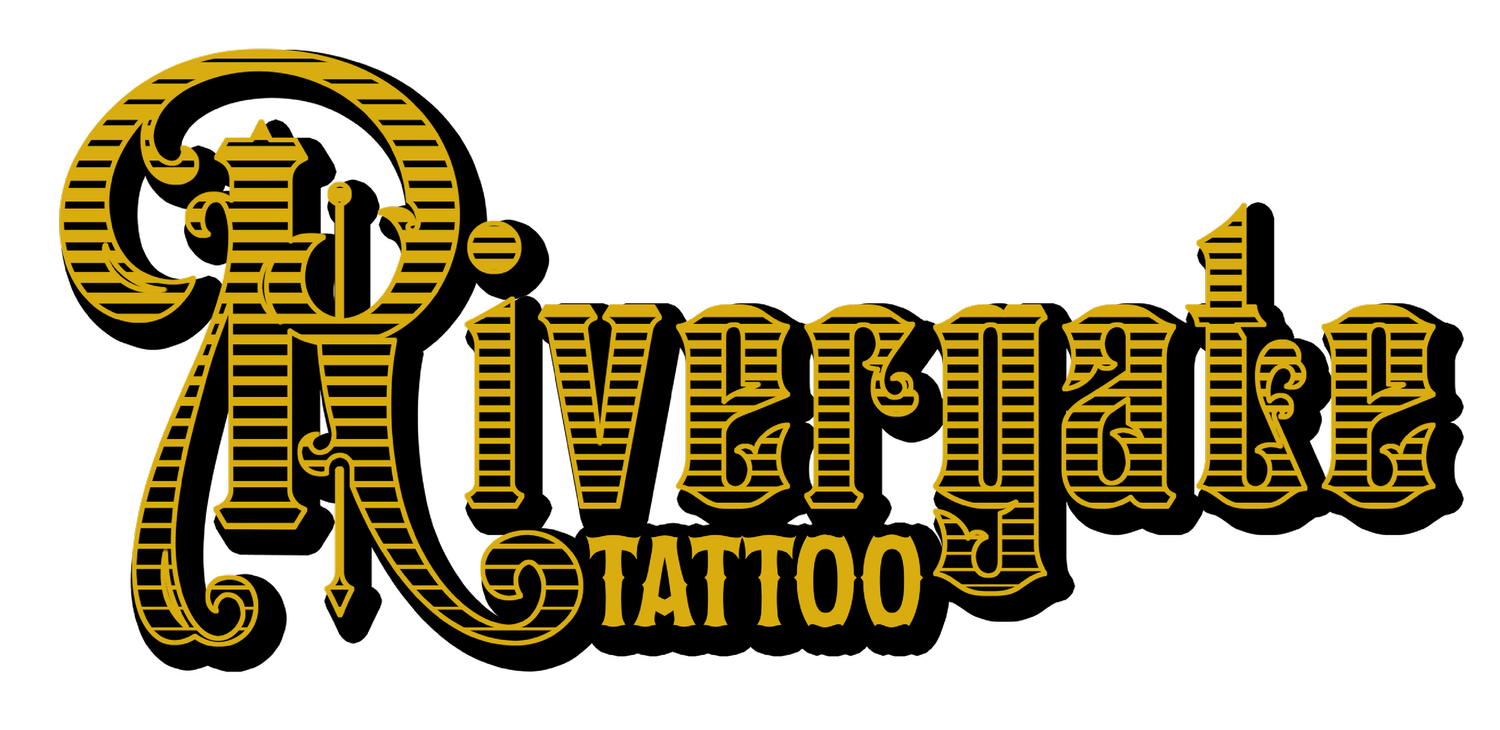
Aftercare
•
Aftercare •
-
1. Leave the bandage on: Keep the bandage on for at least 2–3 hours, or as recommended by your tattoo artist. This helps protect the tattoo from bacteria and prevents rubbing against clothing.
2. Clean your tattoo: After removing the bandage, gently wash the tattoo with lukewarm water and a mild, fragrance-free soap. Avoid scrubbing; use your fingertips to gently cleanse the area.
3. Pat dry: Use a clean paper towel or cloth to gently pat your tattoo dry. Do not rub, as it can irritate the skin. Paper towel is a safer option to avoid cross-contamination. If you do, however, decide to use a cloth or a cotton towel, do not use it for any other purpose as it might carry the bacteria. We also strongly suggest to avoid synthetic materials.
4. Apply ointment: Once the tattoo is dry, apply a thin layer of fragrance-free ointment or a recommended tattoo aftercare cream. Do not over-apply; a thin layer is sufficient.
5. Stay hydrated and healthy: Good hydration and nutrition can help with the healing process. Avoid alcohol and excessive caffeine during the first few days of healing.
6. Keep an eye out for signs of infection: If you notice excessive redness, swelling, pus, foul smell or increased pain, contact your tattoo artist or a healthcare professional immediately.
-
Description text goes hereIn some cases your tattoo artist might suggest using a second skin instead of a cling film to secure the tattoo. Second skin is a type of a medical grade ‘band-aid’ and procedure while using one is slightly different to what you should be doing after using cling film.
PS. If you’re allergic to any adhesive or ever had an allergic reaction to a band-aid, you must make this clear to your tattoo artist, as second skin might cause an allergic reaction.
1. Leave the bandage on: Keep the second skin on for at least 24 hours. If there’s no damages or leakage, you can safely leave it on a fresh tattoo for up to three days. This will speed up the healing process and protect your tattoo from contamination.
2. Removing second skin: Always remove your second skin under warm water – it helps with dissolving the adhesive. Carefully peel the edge of the bandage and proceed to remove it by slowly pulling towards yourself and up, making sure that water can get underneath. Pulling away from your body might result in the scab coming off with the second skin and this can damage the tattoo.
3. Clean your tattoo: After removing the second skin, gently wash the tattoo with lukewarm water and a mild, fragrance-free soap. Avoid scrubbing; use your fingertips to gently cleanse the area. Do not be concern with adhesive residue that might linger on your skin after removing the bandage – it’s safe for your tattoo and will come off with time. Do not rub or attempt to scratch it off as you might damage the skin.
4. Pat dry: Use a clean paper towel or cloth to gently pat your tattoo dry. Do not rub, as it can irritate the skin. Paper towel is a safer option to avoid cross-contamination. If you do, however, decide to use a cloth or a cotton towel, do not use it for any other purpose as it might carry the bacteria. We also strongly suggest to avoid synthetic materials.
5. Apply ointment: Once the tattoo is dry, apply a thin layer of fragrance-free ointment or a recommended tattoo aftercare cream. Do not over-apply; a thin layer is sufficient.
6. Stay hydrated and healthy: Good hydration and nutrition can help with the healing process. Avoid alcohol and excessive caffeine during the first few days of healing.
7. Keep an eye out for signs of infection: If you notice excessive redness, swelling, pus, foul smell or increased pain, contact your tattoo artist or a healthcare professional immediately.
-
If you want for your tattoo to stay beautiful, there’s a list of things you should avoid in the first weeks after getting it – all of them contribute to the way your tattoo will heal:
1. Avoid Tight Clothing: Refrain from wearing tight or restrictive clothing over your tattoo that may cause rubbing or irritation. Loose, breathable clothing is best during the healing period.
2. Avoid Scratching or Picking: It’s natural for your tattoo to itch or peel as it heals, but never scratch or pick at it. Doing so can cause scarring or color loss.
3. Avoid Sun Exposure: Direct sunlight can cause your tattoo to fade or blister. Stay out of the sun until your tattoo is fully healed, and after that, always use sunscreen to protect it.
4. Avoid Swimming: Do not swim in pools, hot tubs, or natural bodies of water (like lakes or oceans) for at least 2–4 weeks, or until your tattoo is fully healed. Excessive moisture and bacteria can lead to infection.
5. Avoid Excessive Moisture: While it’s important to keep your tattoo clean, avoid soaking it in water (like taking long baths) until it’s healed. Quick showers are fine, but avoid prolonged exposure to water.
6. Avoid Touching: Try to avoid touching your tattoo with dirty hands. If you must touch it, make sure your hands are clean and sanitized to prevent bacteria from getting into the healing skin.
7. Avoid Harsh Chemicals: Stay away from harsh soaps, lotions, and fragrances, as well as cleaning products that might irritate the tattoo. Stick to mild, fragrance-free products.
8. Avoid Shaving Over the Tattoo: Do not shave over the tattooed area until it has completely healed. Shaving can irritate the skin and potentially cause damage to the artwork.
9. Avoid Alcohol and Drugs: Alcohol and certain medications can increase blood flow, which may cause excessive bleeding and slow the healing process. Avoid these, especially in the first few days after getting your tattoo.
10. Avoid Sleeping on Your Tattoo: Try not to sleep on the tattooed area during the first few nights to avoid pressure or friction that can damage the skin.
So you got a new tattoo… and now what?
Tattoo is basically an open wound and it should be treated as such: with care and thought behind the process.
To ensure proper healing and to preserve the artwork, follow these aftercare steps carefully:
Your tattoo is a work of art, so treat it with care during the healing process. Thank you for trusting us with your tattoo!
For your healing process and afterwards, in order to keep your tattoos beautiful despite passing time, we proudly recommend Underdog products.
Underdog Tattooing Balm is a handmade, natural, and organic product designed to support the tattoo process and ensure optimal healing. Since 2017, this UK-based family business has created tattoo products with a deep commitment to quality and skin health, using only the finest vegan ingredients.
When used as aftercare, Underdog Tattooing Balm helps to nourish and protect fresh tattoos. It is recommended to apply a small amount 3 to 4 times a day, or as advised by the tattoo artist, using clean hands.
The balm is free from petroleum and parabens, and is enriched with skin-soothing ingredients like coconut oil, shea butter, and calendula oil, which aid in moisturizing and healing the skin. Additionally, Vitamin E oil supports skin restoration and scar healing, ensuring the tattoo heals beautifully and stays vibrant over time.
Underdog Tattooing Balm has been extensively tested by tattooists for tattooists, providing peace of mind that it will help tattoos stand the test of time.





